In the dense, verdant jungles of Southeast Asia lies one of nature’s most extraordinary masters of disguise. The Asian vine snake (Ahaetulla prasina), also known as the green vine snake, has evolved a remarkable camouflage strategy that exemplifies the pinnacle of natural mimicry. When coiled among foliage, this slender reptile doesn’t simply blend with leaves—it transforms its body to mimic the intricate vein patterns found on leaves. This sophisticated adaptation represents one of the most impressive examples of evolutionary camouflage in the reptile world, allowing these snakes to become virtually invisible to both predators and prey. Their remarkable ability to imitate not just the color but the structural patterns of their environment demonstrates the incredible adaptability that has helped these specialized hunters survive for millions of years.
The Master of Leaf Mimicry: Introducing the Asian Vine Snake
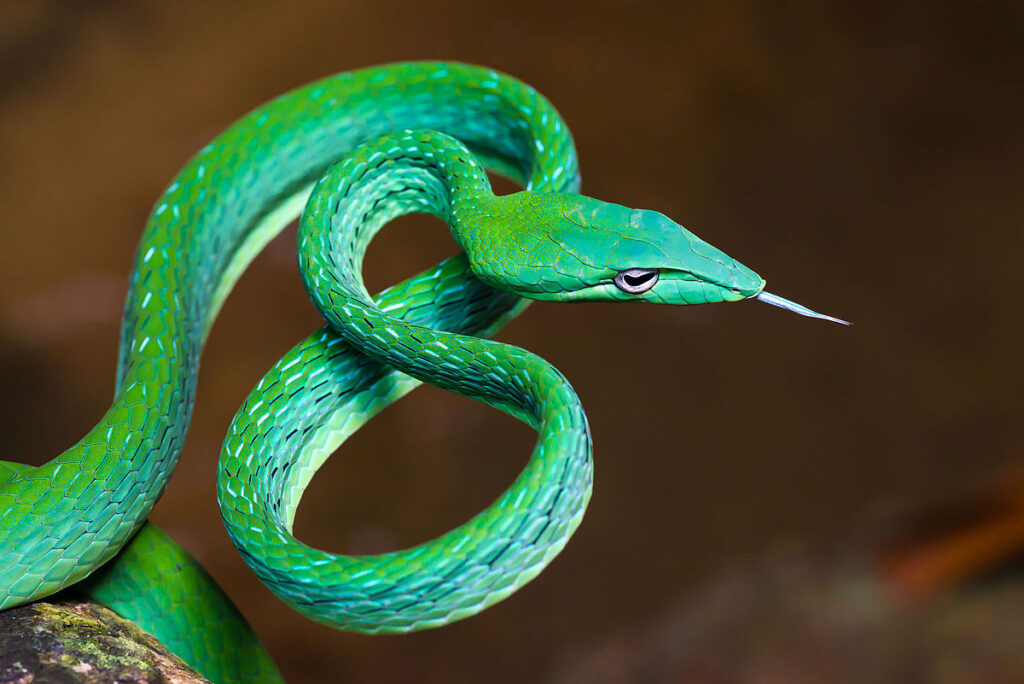
The Asian vine snake (Ahaetulla prasina) is a slender, long-bodied reptile that has perfected the art of botanical disguise within its rainforest habitat. Growing up to 2 meters in length, these snakes possess exceptionally thin bodies, sometimes no thicker than a pencil, which contributes significantly to their leaf-like appearance. Their most distinctive feature is an elongated, pointed snout that resembles a leaf tip, further enhancing their disguise when positioned among foliage. The vine snake’s remarkable ability to remain motionless for extended periods completes the illusion, as they hang from branches or coil among leaves with a patience that defies detection by even the keenest observers.
Evolutionary Journey to Perfect Camouflage
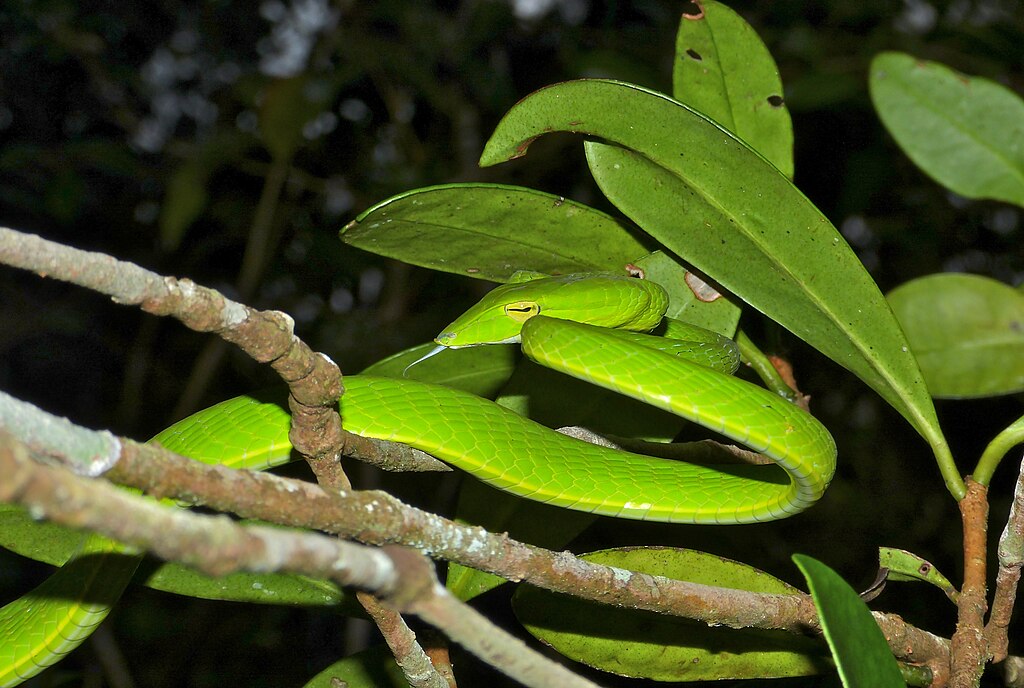
The vine snake’s remarkable mimicry didn’t develop overnight but rather represents millions of years of evolutionary refinement driven by survival pressures. Researchers believe this specialized camouflage evolved through natural selection, as snakes with better leaf-resembling traits survived at higher rates than their more visible counterparts. The pressure from both predators seeking to eat these snakes and prey animals evolving to detect them created an evolutionary arms race that pushed the vine snake toward increasingly sophisticated disguise mechanisms. What makes this adaptation particularly fascinating is how multiple physical features—body shape, coloration, behavior, and even scale arrangement—all evolved in concert to create a comprehensive mimicry system that works on multiple visual levels.
Anatomical Adaptations That Enhance the Illusion

The Asian vine snake’s body is specifically adapted to enhance its leaf mimicry through several key anatomical features. Most notably, its scales have evolved a slight ridge pattern that, when viewed from certain angles, creates light and shadow effects remarkably similar to the vein structure of leaves. Their horizontally elongated pupils—unlike the vertical slits of many other snakes—help maintain the leaf-like appearance even in their eyes, one of the most difficult features to disguise in nature. The snake’s body is laterally compressed (flattened from side to side), creating a leaf-like profile when viewed from the side. Even the snake’s ventral (belly) scales are modified to be sharper and more keeled, helping it to balance perfectly along thin branches while maintaining its disguise.
The Science Behind the Coloration
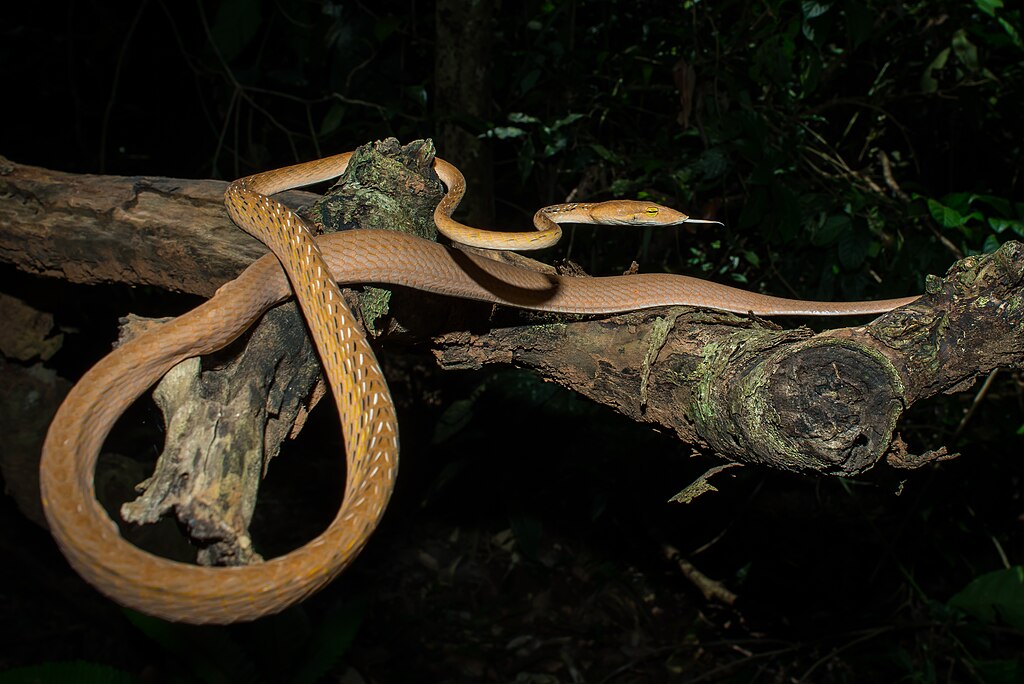
The vine snake’s green coloration represents a complex biological system rather than simple pigmentation. These snakes possess specialized chromatophores (color-bearing cells) that can adjust their exact shade of green to match surrounding foliage, helping them blend seamlessly into different microenvironments within their habitat. Interestingly, some individuals display variations with blue, yellow, or even brown color phases, allowing populations to adapt to seasonal changes in their environment when leaves change color. Research has shown that their scales contain guanine crystals that reflect light in specific wavelengths, enhancing the green appearance and creating subtle iridescence similar to the waxy surface of leaves. This coloration system is complemented by a pattern of fine white or yellow lines along the body that mimic leaf veins with remarkable accuracy.
Behavioral Tactics That Complete the Disguise
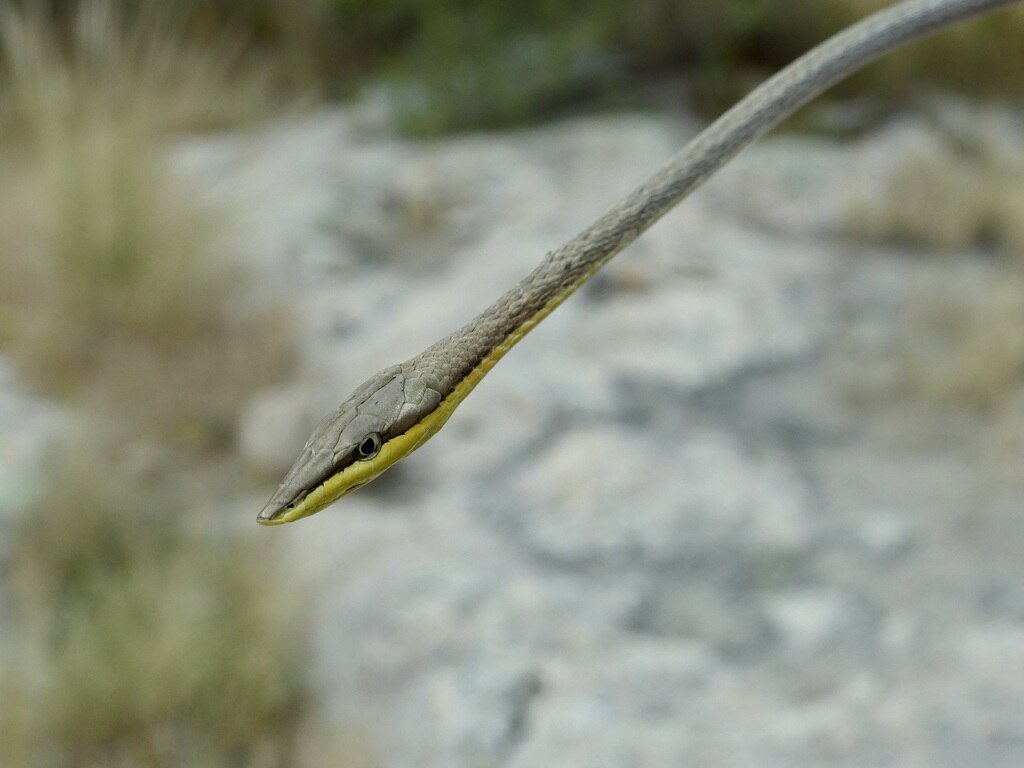
The vine snake’s mimicry extends beyond physical appearance into sophisticated behavioral adaptations that complete their disguise. When threatened or hunting, these snakes will often position themselves along branches with their bodies in gentle S-shaped curves that perfectly mimic the natural undulations of vines and stems. Perhaps most impressively, they exhibit a swaying motion in light breezes that precisely matches the movement of surrounding leaves, making detection nearly impossible even when in motion. When coiled, they arrange their body segments in overlapping patterns that create the impression of a cluster of leaves with visible veining. Researchers have documented these snakes maintaining completely motionless positions for up to eight hours when necessary, demonstrating extraordinary muscle control and patience in maintaining their disguise.
Hunting Strategies of the Invisible Predator
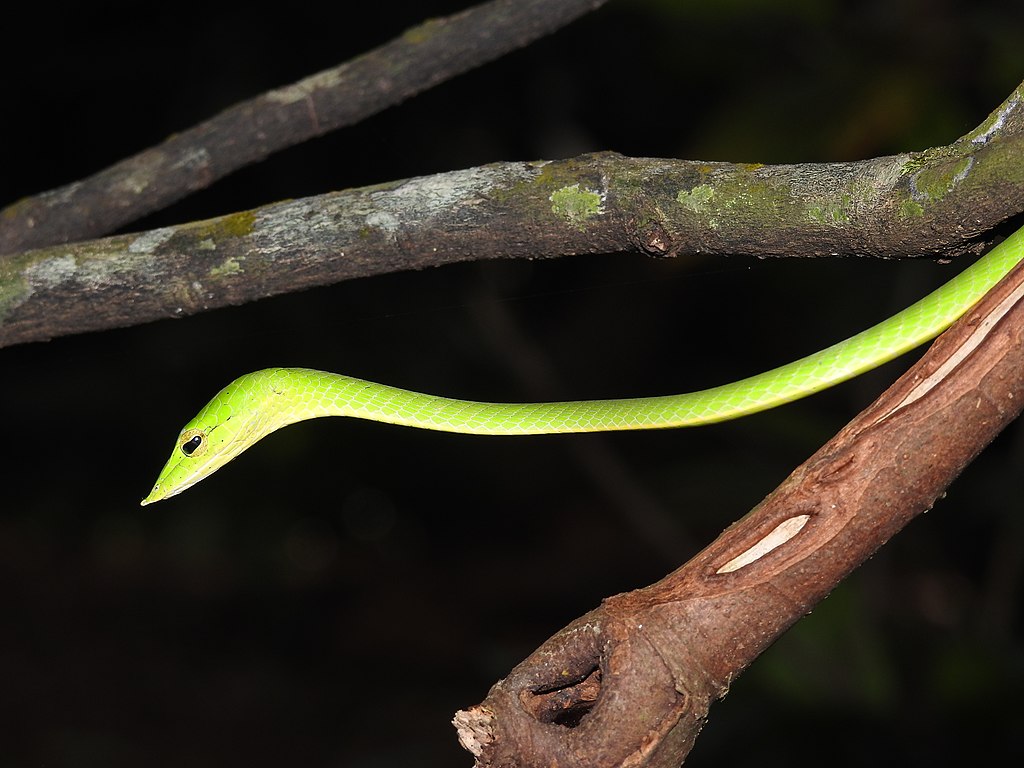
The vine snake’s exceptional camouflage serves primarily as a hunting adaptation, allowing these ambush predators to strike with deadly precision. Unlike many snakes that actively pursue prey, vine snakes are primarily “sit-and-wait” hunters that remain perfectly disguised until suitable prey comes within striking distance. When a potential meal—typically small lizards, frogs, or birds—ventures close enough, the snake launches forward with remarkable speed, capturing prey with its slightly venomous rear fangs. Their hunting strategy relies heavily on the element of surprise, with studies showing success rates dropping dramatically if they’re spotted before striking. Most fascinating is their use of what scientists call “oscillatory targeting,” a technique where they sway slightly to better judge distance before striking, all while maintaining their leaf-like appearance.
Distribution and Natural Habitat

Asian vine snakes occupy a vast range across Southeast Asia, including Thailand, Malaysia, Indonesia, the Philippines, and parts of India. These specialized reptiles are strictly arboreal, rarely descending to the ground and spending virtually their entire lives in the middle to upper canopy of tropical forests. They show a distinct preference for dense vegetation with high humidity levels, particularly favoring habitats with abundant thin branches and vine networks where their camouflage is most effective. Interestingly, different regional populations have developed subtle variations in their leaf mimicry to match the predominant leaf types in their specific habitat, with southern populations generally displaying more elongated shapes mimicking the narrower leaves common in their range. Conservation biologists have noted that vine snakes are particularly vulnerable to habitat fragmentation, as their specialized adaptations make them poorly suited to crossing open areas between forest patches.
Similar Mimicry in Other Snake Species
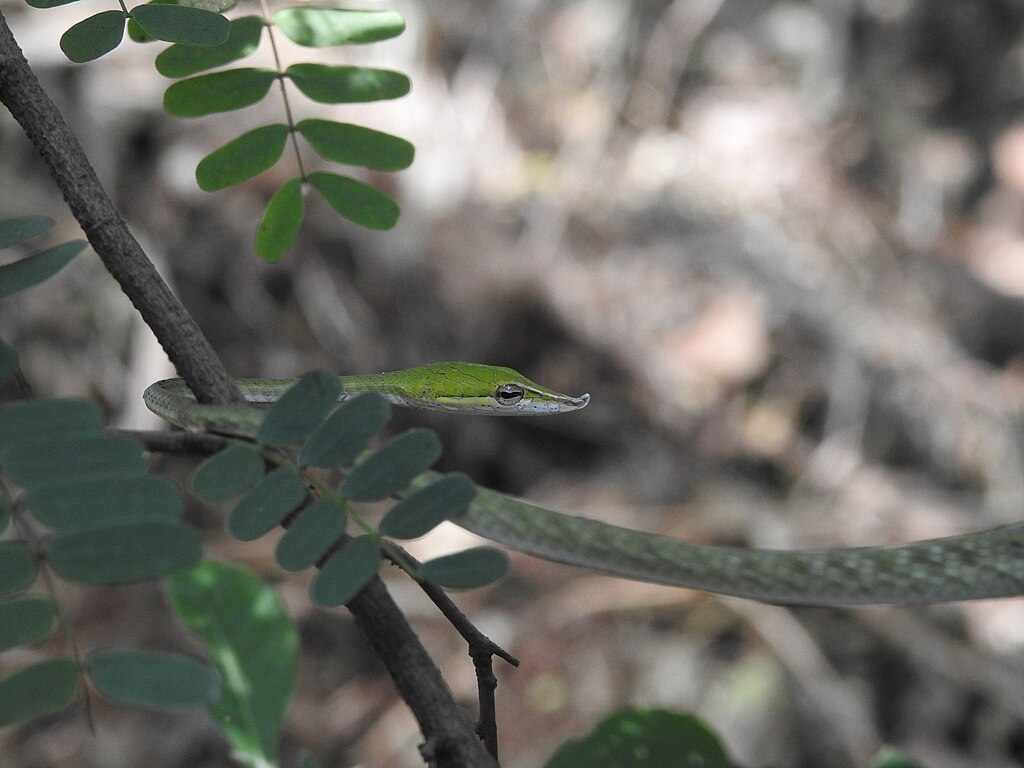
While the Asian vine snake represents perhaps the most refined example of leaf vein mimicry, this evolutionary strategy appears in several other snake species across different continents. The South American parrot snake (Leptophis ahaetulla) has independently evolved a remarkably similar appearance and behavior, demonstrating convergent evolution in response to similar environmental pressures. The African vine snake (Thelotornis kirtlandii) has developed comparable camouflage but with the added feature of being able to flatten its neck region to mimic broader leaf structures. The Australian rough-scaled snake (Tropidechis carinatus) exhibits a less specialized but still effective form of leaf mimicry, suggesting this adaptation has emerged multiple times in snake evolution. Herpetologists studying these parallel adaptations have discovered that despite their visual similarities, these mimicry systems evolved through different genetic pathways, highlighting nature’s diverse routes to similar solutions.
The Role of Venom in Leaf-Mimicking Snakes
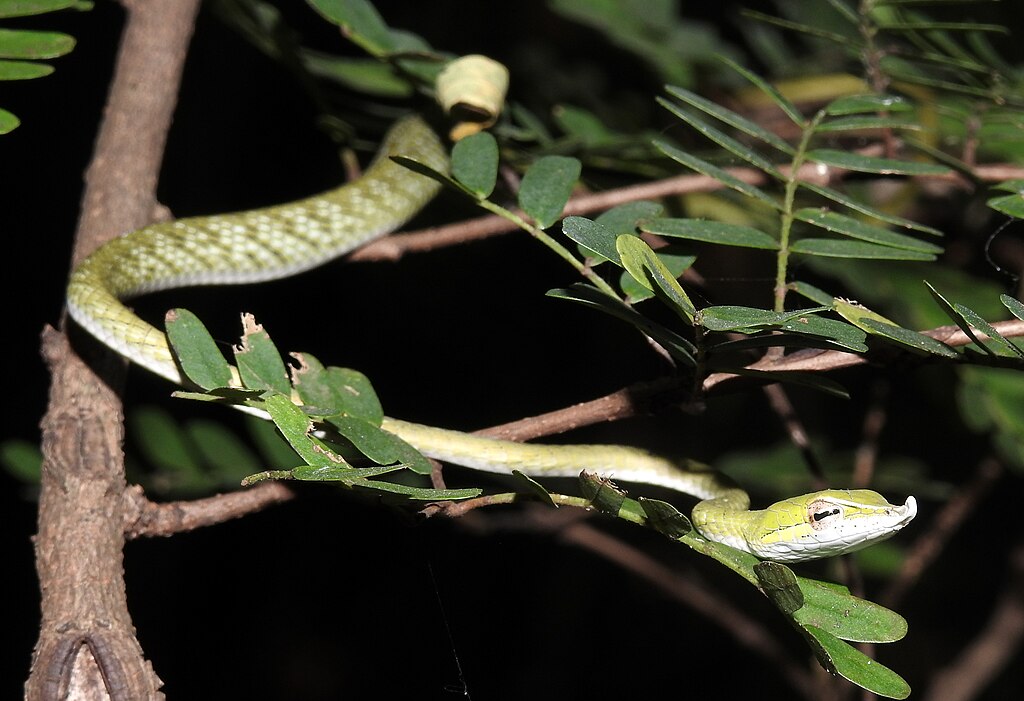
Unlike many other highly camouflaged snakes that are non-venomous, the Asian vine snake possesses a mild venom delivered through specialized rear fangs—a system known as opisthoglyphous. This venom is not typically dangerous to humans but is highly effective against the small vertebrates that make up their diet. The toxin works primarily as a digestive aid and immobilizing agent, causing rapid paralysis in small prey while beginning the digestive process before consumption. Interestingly, research suggests their relatively mild venom correlates directly with their exceptional camouflage—species with more effective disguises often evolve less potent venoms since they can approach prey more closely before striking. The specific composition of vine snake venom includes unique neurotoxic components that specifically target the nervous systems of lizards and amphibians, their primary prey, demonstrating another layer of specialized adaptation.
Reproduction and Life Cycle Adaptations

The reproductive strategy of vine snakes has also evolved to complement their camouflage-dependent lifestyle. Unlike many snakes that lay eggs on the ground, female vine snakes are ovoviviparous, retaining eggs within their bodies until they hatch, then giving birth to fully-formed young snakes. This strategy protects developing offspring during their most vulnerable stage while allowing the mother to remain in the safety of the canopy. Newborn vine snakes emerge already displaying the green coloration and basic shape of adults, though their leaf vein mimicry becomes more refined as they mature. Young snakes begin hunting almost immediately, focusing on very small prey like tiny tree frogs and geckos until they grow large enough for more substantial meals. Remarkably, juvenile vine snakes instinctively know how to position themselves to maximize their camouflage without needing to learn this behavior, demonstrating that these complex positioning behaviors are genetically encoded rather than learned.
Threats to Survival in the Modern World
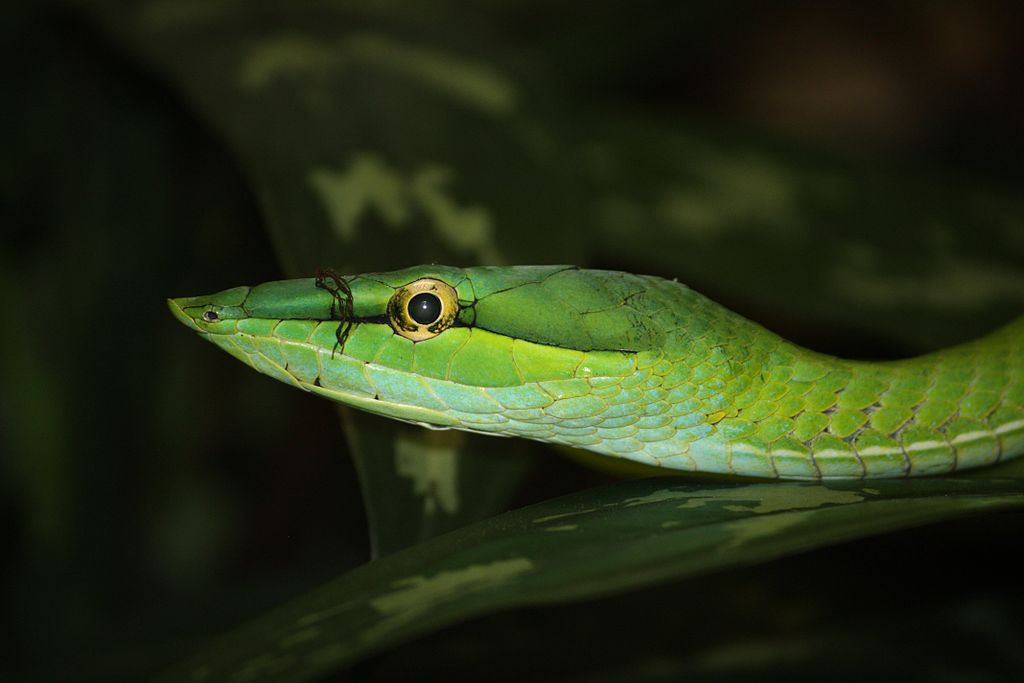
Despite their remarkable adaptations, vine snakes face mounting challenges in the contemporary world. Habitat destruction, particularly the rapid deforestation of Southeast Asian rainforests for palm oil plantations and timber, represents their greatest threat by eliminating the specialized environments their camouflage evolved to exploit. Climate change poses another significant danger, as even subtle shifts in seasonal patterns can disrupt the synchronization between snake coloration and leaf cycles. The international exotic pet trade has also targeted these snakes for their unusual appearance, with thousands captured annually despite their poor survival rates in captivity. Conservation biologists have noted with particular concern that vine snakes are especially vulnerable to forest fragmentation since their specialized arboreal lifestyle makes crossing even small clearings between forest patches extremely dangerous, effectively isolating populations and reducing genetic diversity.
Studying Nature’s Masters of Disguise
Researching vine snakes presents unique challenges for scientists due to their exceptional camouflage, making field observation extraordinarily difficult. Modern research often employs specialized techniques, including infrared imaging, that can detect the slightly different heat signature of the snake against vegetation backgrounds. Radio telemetry using miniaturized transmitters has revolutionized tracking studies, though researchers must be careful that attached devices don’t compromise the snake’s camouflage or movement abilities. DNA analysis of environmental samples (known as eDNA) has emerged as a non-invasive way to confirm vine snake presence in areas where visual confirmation is challenging. Beyond herpetology, these remarkable reptiles have inspired biomimetic research in various fields, with military camouflage designers and robotics engineers studying the principles behind their effective disguise for potential technological applications.
Conservation Efforts and Future Prospects

Several conservation initiatives specifically target vine snakes and their forest habitats throughout Southeast Asia. Protected area designation has proven most effective, with regions like Thailand’s Khao Sok National Park maintaining healthy populations through strict habitat preservation policies. Community-based conservation programs educate local populations about these harmless and ecologically important snakes, helping reduce persecution based on fear and misunderstanding. Captive breeding programs exist at specialized institutions, though their primary purpose remains research rather than reintroduction, as the complex habitat requirements make successful reestablishment challenging. The future of these remarkable reptiles ultimately depends on the broader conservation of intact forest canopies across their range, highlighting how specialized adaptations that evolved over millions of years can become vulnerabilities when environments change rapidly due to human activity.
The Asian vine snake represents one of nature’s most perfect examples of evolutionary adaptation. Its ability to transform its body into a near-perfect replica of leaf veins when coiled demonstrates the extraordinary potential of natural selection to craft solutions to survival challenges. Beyond their biological significance, these remarkable reptiles remind us of the countless wonders still hidden within our planet’s rainforests, many potentially undiscovered or understudied. As we continue to better understand the sophisticated mechanisms behind their camouflage, vine snakes offer valuable lessons about adaptation, specialization, and the delicate balance between evolutionary advantage and vulnerability in a changing world. Their future, like that of many specialized species, remains uncertain, but their remarkable story continues to inspire both scientific inquiry and conservation efforts aimed at preserving nature’s most extraordinary innovations.




